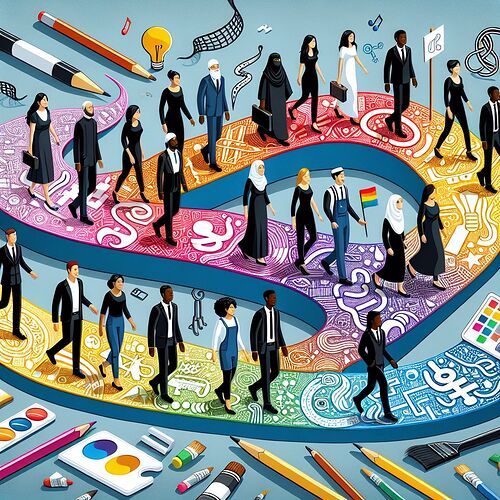Embarking on a career in graphic design can be both exciting and rewarding. This field blends creativity with technical skills to communicate ideas visually. Whether you're a beginner or looking to advance your career, understanding the various paths and opportunities available in graphic design is essential.
Introduction
Graphic design is a diverse field that encompasses various specializations and career paths. From branding and advertising to web design and multimedia, graphic designers play a crucial role in shaping visual communication.
Educational Background
While some graphic designers are self-taught, many pursue formal education to gain foundational knowledge and skills. Here are some common educational paths:
- Associate Degree in Graphic Design:
- A two-year program that provides basic design principles, software skills, and portfolio development.
- Bachelor's Degree in Graphic Design:
- A four-year program offering comprehensive training in design theory, art history, typography, and advanced software skills.
- Online Courses and Certifications:
- For those seeking flexibility, numerous online platforms offer courses and certifications in graphic design.
Essential Skills
Graphic designers must possess a blend of technical and creative skills. Here are some key skills required:
- Adobe Creative Suite: Proficiency in software like Photoshop, Illustrator, and InDesign is crucial.
- Typography: Understanding fonts, typefaces, and their impact on design.
- Color Theory: Knowledge of color schemes and their psychological effects.
- Layout and Composition: Arranging visual elements effectively.
- Creativity: Generating innovative ideas and concepts.
- Communication: Effectively conveying ideas to clients and team members.
Career Paths
Graphic design offers a variety of career paths, each with its own set of responsibilities and opportunities. Here are some common roles:
- Junior Graphic Designer: Entry-level position focusing on creating design elements under supervision.
- Senior Graphic Designer: More experienced role involving project management and leadership.
- Art Director: Oversees the visual style and content in magazines, newspapers, product packaging, and movie and television productions.
- Creative Director: Leads the creative team and manages the overall vision of projects.
- Web Designer: Specializes in designing websites, focusing on layout, user experience, and visual appearance.
- UX/UI Designer: Focuses on user experience and interface design, ensuring products are user-friendly and visually appealing.
- Freelance Graphic Designer: Works independently, taking on various projects from different clients.
Portfolio Development
A strong portfolio is essential for showcasing your skills and landing job opportunities. Here are some tips for building an impressive portfolio:
- Include Diverse Projects: Showcase a range of work to demonstrate versatility.
- Highlight Your Best Work: Focus on quality over quantity.
- Provide Context: Explain the goals, challenges, and solutions for each project.
- Keep It Updated: Regularly add new work and remove outdated projects.
Networking and Professional Development
Building a network and continuing to develop professionally are key to a successful career in graphic design. Consider the following:
- Join Professional Organizations: Organizations like AIGA offer networking opportunities and resources.
- Attend Industry Events: Conferences, workshops, and meetups can help you connect with other professionals.
- Stay Current: Keep up with design trends and new technologies by following industry blogs and taking courses.
Conclusion
A career in graphic design offers numerous opportunities for creativity and professional growth. By acquiring the necessary skills, building a strong portfolio, and continually developing professionally, you can pave the way for a successful and fulfilling career in this dynamic field.
Did I miss anything? Add your comments below!
